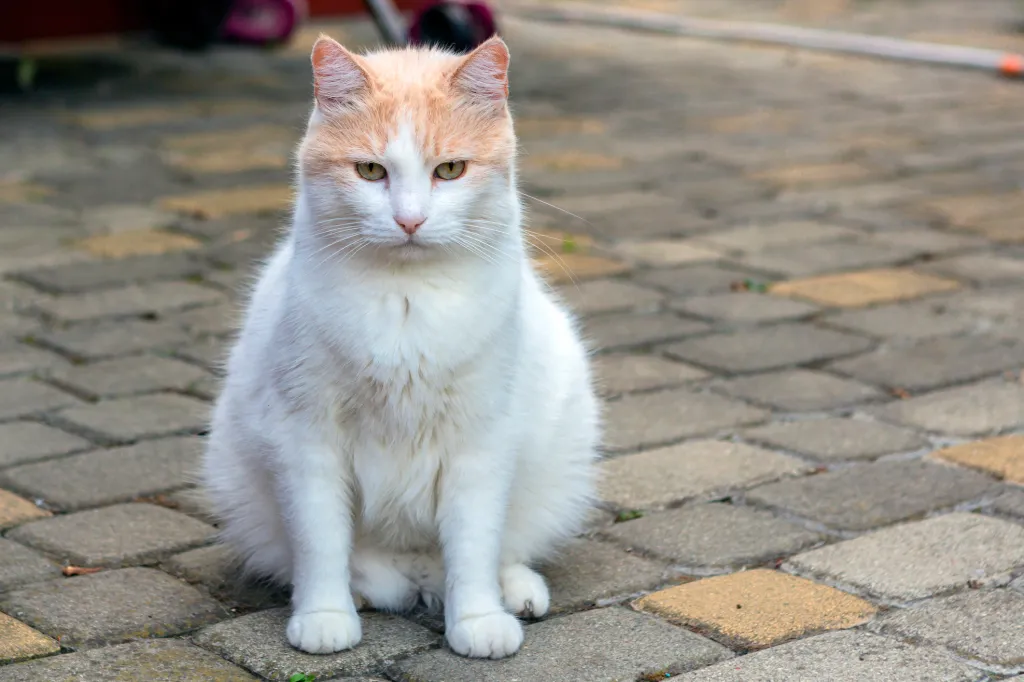While the Turkish Van Cat is not very fond of sitting on laps, they will happily cuddle next to you and sleep in your bed. They are one of the few domestic cat breeds that are completely comfortable in water. In fact, they may even try to play in your bathtub, sink, or even the toilet if you’re not careful.
The Van is not a cat that you should leave home alone for long periods of time. They are highly intelligent and need plenty of stimulation to prevent boredom. If they don’t get it, they may create their own fun by engaging in destructive behavior. Also, don’t leave your breakable items out in the open, as Turkish Van cats have a habit of knocking things over just to see what will happen.
When considering a Turkish Van, it’s advisable to prioritize adopting from rescue organizations or shelters to provide a loving home to a cat in need. However, if you decide to purchase, it’s crucial to choose a reputable breeder. Conduct thorough research to ensure that the breeder follows ethical practices and prioritizes the well-being of their cats. Reputable Turkish Van breeders prioritize the health and temperament of their cats, conduct necessary health screenings, and provide a nurturing environment for the kitties. This active approach ensures that you bring home a healthy and happy kitty while discouraging unethical breeding practices.
Quick Facts
- Origin: Turkey
- Size: Medium
- Breed Group: Natural
- Lifespan: 12-15 years
- Coat: Long, soft, and silky, with a water-resistant undercoat
- Temperament: Intelligent, playful, and affectionate
- Exercise Needs: Moderate to high
- Training: Relatively easy to train
- Grooming: Regular brushing to remove loose hair and prevent mats
- Health: Generally healthy, but can be prone to certain genetic health conditions, such as cardiomyopathy and hip dysplasia
- Some Turkish Van cats have a mark between their shoulders, called the “thumbprint of Allah.” This means the cat is blessed.
- These cats love water, and it is best to keep the toilet seat down when they live in your home. They are built for speed in the water.
- This is one of the oldest cat breeds. Folklore states that two Turkish Vans swam onto Noah’s Ark.
- The position of the color marks is called the van pattern. It is genetic.
Turkish Van Pictures






-
Affectionate with Family
Some cat breeds are typically independent and aloof, even if they’ve been raised by the same person since kittenhood; others bond closely to one person and are indifferent to everyone else; and some shower the whole family with affection. Breed isn’t the only factor that goes into affection levels; cats who were raised inside a home with people around feel more comfortable with humans and bond more easily.

See Cats Less Affectionate with Family -
Amount of Shedding
If you’re going to share your home with a cat, you’ll need to deal with some level of cat hair on your clothes and in your house. However, shedding does vary among the breeds. If you’re a neatnik, you’ll need to either pick a low-shedding breed or relax your standards. This furniture cover can make it easier to clean up cat hair and keep it off your sofa!
-
General Health
Due to poor breeding practices, some breeds are prone to certain genetic health problems. This doesn’t mean that every cat of that breed will develop those diseases; it just means that they’re at an increased risk. If you’re looking only for purebred cats or kittens, it’s a good idea to find out which genetic illnesses are common to the breed you’re interested in.
-
Potential for Playfulness
Some cats are perpetual kittens—full of energy and mischief—while others are more serious and sedate. Although a playful kitten sounds endearing, consider how many games of chase the mouse-toy you want to play each day, and whether you have kids or other animals who can stand in as playmates. A classic wand cat toy like this one is perfect for playful felines!
-
Tendency to Vocalize
Some breeds sound off more often than others with meows, yowls, and chattering. When choosing a breed, think about how the cat vocalizes and how often. If constant “conversation” drives you crazy, consider a kitty less likely to chat.
-
Kid-Friendly
Being tolerant of children, sturdy enough to handle the heavy-handed pets and hugs they can dish out, and having a nonchalant attitude toward running, screaming youngsters are all traits that make a kid-friendly cat. Our ratings are generalizations, and they’re not a guarantee of how any breed or individual cat will behave; cats from any breed can be good with children based on their past experiences and personality.
-
Friendly Toward Strangers
Stranger-friendly cats will greet guests with a curious glance or a playful approach; others are shy or indifferent, perhaps even hiding under furniture or skedaddling to another room. However, no matter what the breed, a cat who was exposed to lots of different types, ages, sizes, and shapes of people as a kitten will respond better to strangers as an adult.
-
Easy to Groom
Some breeds require very little in the way of grooming; others require regular brushing to stay clean and healthy. Consider whether you have the time and patience for a cat who needs daily brushing. You should definitely pick up this awesome de-shedding tool for cats of any hair length!
-
Intelligence
Some cat breeds are reputed to be smarter than others. But all cats, if deprived the mental stimulation they need, will make their own busy work. Interactive cat toys are a good way to give a cat a brain workout and keep them out of mischief. This scratcher cat toy can keep your smart kitty busy even when you’re not home!
-
Pet Friendly
Friendliness toward other household animals and friendliness toward humans are two completely different things. Some cats are more likely than others to be accepting of other pets in the home.
Turkish Van History
Known as the swimming cat for his propensity to play in bodies of water—or at least to enjoy splashing his paws in it—the Turkish Van is an ancient breed thought to have originated in the Lake Van area of Turkey. The mountainous and rugged landscape and cold climate of the region no doubt contributed to the development of the Van’s cashmere-like coat and solidly built body.
The Turkish Van is a natural breed and has probably existed in his homeland for centuries. Legend has it that he swam ashore from Noah’s ark, which tradition says landed on Mount Ararat in Turkey, not far from Lake Van.
How did the Van come by his spots of color? Both Jewish and Islamic tradition say that the cats were the recipients of a divine touch that imparted color to their formerly white coat. On the ark, a door slammed on the cat’s tail, turning it red, and God reached out and touched the cat on the head, leaving a spot where his hand rested. In the Islamic version, Allah touched the cat on the back, and the spot that is sometimes seen on a Turkish Van’s back is known as the thumbprint of Allah.
However he came to be, the Van has been attractive to many of Turkey’s invaders and visitors over the years. At least a few probably made their way to Europe as “souvenirs” in the past millennium. It wasn’t until the 1970s, though, that a Turkish Van was first brought to the United States. The International Cat Association recognized the breed in 1985, and the Cat Fanciers Association began registering it in 1988. In Turkey, the cats are considered national treasures, and their preservation is overseen by the Turkish College of Agriculture and the Ankara Zoo.
Turkish Van Size
Turkish Vans weigh 10 to 18 pounds at maturity.
Turkish Van Personality
When he is properly socialized in kittenhood, this is a social and affectionate cat who is strongly attached to members of his family, although he may choose one or two as his favorites. He is highly active and athletic, remaining playful into his senior years. Athletic doesn’t mean graceful, however. The Van is big and ungainly; this is one cat who doesn’t always land on his feet.
Turkish Vans are highly intelligent and can learn tricks and games, including playing fetch. They like teaser toys that allow them to mimic pouncing on prey. And if you can’t find your Van, look up; he is probably perched overhead, as high as he can get. Don’t put anything on display that is easily broken; the Van has a wicked sense of humor and may enjoy pushing items off a shelf just to see what happens. Or sometimes he’s just clumsy.
The Van may or may not be a good traveler. Trips to the veterinarian often involve the cat vomiting, peeing or pooping in the car. If you like to RV or take road trips with your cat, ask the breeder if cats in her line are prone to carsickness. The Van’s love of water can lead him into trouble. Put down toilet seats and cover swimming pools and spas if you aren’t there to supervise his aquatic excursions. And resign yourself to finding your faucets dripping. He can easily learn to turn them on so he can drink from them or play in the sink. It’s not unusual for a Van to simply enjoy lying in water, especially during hot weather.
A Van dislikes being held or restrained, and it is a rule at cat shows that the cats are displayed on the table instead of being held up in the air. Most notably, if you are ever unsure of how a Van is feeling, pay attention to his Vanometer. That pretty shell-pink nose will start to turn red if your Turkish Van is upset. If his nose shading from pink to crimson, heed the warning and leave him alone. He’s not much of a lap cat, but the Van will be happy to cuddle next to you and sleep in your bed. He will also give firm direction as to the proper way to pet him.
Turkish Van Health
Both pedigreed cats and mixed-breed cats have varying incidences of health problems that may be genetic in nature. Turkish Vans are generally healthy, although some have been reported to develop the following:
- Hypertrophic Cardiomyopathy: HCM is a common heart condition in some cats. It involves the thickening of the heart muscles, which can affect the heart’s ability to function properly. Regular veterinary check-ups and echocardiograms can help detect and manage HCM.
Turkish Van Care
The Turkish Van has a single coat with a silky texture. Because there’s no undercoat to cause mats or tangles, it’s easy to groom with weekly combing or brushing with a slicker brush. It sheds very little except during spring and fall when old coat is falling out or new coat is coming in. Older cats may have difficulty grooming themselves thoroughly, so it can be a good idea to brush or comb them more often. The Turkish Van‘s coat is water-resistant, so be glad that baths are rarely necessary.
Brush the teeth to prevent periodontal disease. Daily dental hygiene is best, but weekly brushing is better than nothing. Trim the nails every couple of weeks. Wipe the corners of the eyes with a soft, damp cloth to remove any discharge. Use a separate area of the cloth for each eye so you don’t run the risk of spreading any infection. Check the ears weekly. If they look dirty, wipe them out with a cotton ball or soft damp cloth moistened with a 50-50 mixture of cider vinegar and warm water. Avoid using cotton swabs, which can damage the interior of the ear.
Keep the litter box spotlessly clean. Cats are very particular about bathroom hygiene, and a clean litter box will also help to keep the long coat clean. It’s a good idea to keep a Turkish Van as an indoor-only cat to protect him from diseases spread by other cats, attacks by dogs or coyotes, and the other dangers that face cats who go outdoors, such as being hit by a car. Turkish Vans who go outdoors also run the risk of being stolen by someone who would like to have such a beautiful cat without paying for it.
Turkish Van Coat Color And Grooming
You might think that the Turkish Van is a white cat with patches of color, but genetically you would be wrong. He is, in fact, a colored cat with very large patches of white, a pattern caused by the piebald white spotting gene. The result is a cat whose body is mostly white, with colored markings on the head and tail. He may also have random spots of color on the body and legs. This type of coloring is sometimes seen in other breeds and is known as the Van pattern.
Colors seen in the breed include red, cream, black, blue, tabby in red, cream, brown and blue, and various shades of tortoiseshell. Nose leather is pink, as are paw pads, although they can sometimes have color spots. The Turkish Van has a broad, wedge-shaped head with a rounded muzzle, moderately large ears with slightly rounded tips, and moderately large rounded eyes that can be blue, amber, or one of each color.
As befits a cat who was formed to survive in a rugged landscape and climate, he has a strong, powerful body with a broad chest and shoulders and long, muscular legs. Males are much larger and more muscular than females. Keeping the Turkish Van cozy is a soft, semi-long single coat with feathering (longer hair) on the ears, legs, feet and belly, a ruff around the neck, and a fully plumed tail.
Kittens and young adults have a less developed coat than mature adults. The coat doesn’t achieve its full length until the cat is at least two years old. In summer the coat is short, but it becomes substantially longer and thicker in winter. This is a large breed; they can take three to five years to reach their full size.
Children And Other Pets
The Van who has been well socialized is comfortable with kids, making him a good choice for families with active children who will enjoy running around with a teaser toy, throwing a ball for the cat to fetch, or teaching tricks. Supervise young children to make sure they pet the cat nicely and don’t pull his fur or tail.
The Turkish Van is happy to live with cat-friendly dogs, too, as long as they recognize that he’s in charge. When it comes to cats, he prefers the company of his own kind, but he will accept other cats, especially if he is brought up with them from kittenhood. In any case, introduce pets slowly and in controlled circumstances to ensure that they learn to get along together.
Turkish Van Rescue Groups
More Info For You
If you’re also looking for a dog, check out DogTime’s dog breed page!





